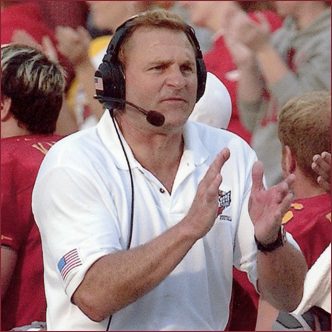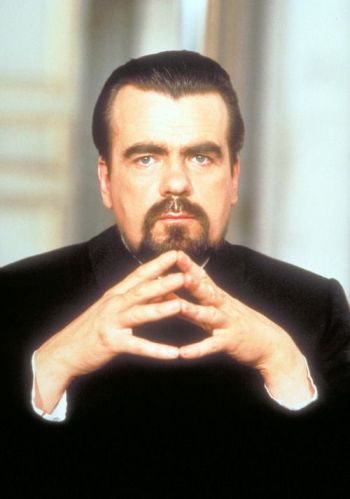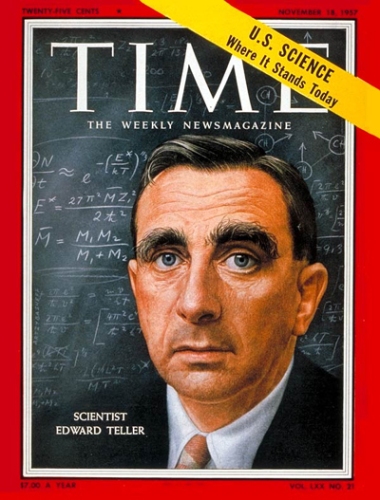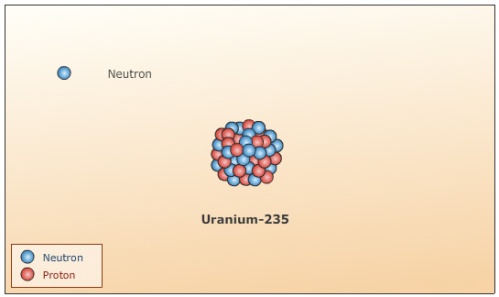Let’s hear it for the Iowa State Hawkeyes! Or is it the Iowa Cyclones?

While the nicknames, Hawkeyes and Cyclones, should be easily distinguished, Iowa State University and the University of Iowa’s mascots are justifiably confused by outsiders: one of them is a bird, and the other… is a bird, too. Here’s Herky, Iowa’s mascot, in stocky, glowering, uppercut form.

The first image of this post is of Cy the Cardinal. It’s one of the more amiable depictions of Iowa State’s mascot. This was Iowa State’s logo during the Criner-Walden era (1983-1994). Although it may not be apparent to non-Iowans, the “I” towering above Cy looks suspiciously like the “I” on Herky’s jersey. Outlining Cy’s “I” with black was a curious choice considering the primary intrastate rival’s colors are gold and black.
Whether or not Criner picked or even designed this logo is difficult to know. He wasn’t in Ames for long: Iowa State fired Criner at the conclusion of his fourth and only winning season at 6-5. Actually, he was 5-4 because he got fired with two games to go. Chuck Banker took over and split the last two games. Banker is the only Iowa State football head coach to go 0.500 since Earl Bruce.
(Bruce left Iowa State after six seasons for Ohio State in 1978. In Bruce’s first year as a Buckeye, his team was undefeated in the regular season and lost the national championship by a point in the 1980 Rose Bowl. Bruce is the only Iowa State football head coach elected to the College Football Hall of Fame.)
I remember Criner as funny lookin’.

Although an unremarkable coach succeeded Criner, his legacy seems largely lost. His tenure ended well before the internet age. The most interesting thing about Criner is the dearth of Iowa State vintage photos on the web; the only one I found is posted above. Wikipedia has more information about his time at Boise State than Iowa State. This article in the LA Times indicates his program might have been on the unethical side.
Iowa State fans endured eight mostly mediocre seasons under Jim Walden; his team failed to win a game in his eighth and final year. Walden resigned before the season’s end and offered the following advice to future Cyclone head coaches: “If you stay, you’re going to lose and you’re going to get fired.”

High-domed baseball caps and aviators with dainty straps while chewing a hunk of tobacco might have been macho in the wake of Ronald Reagan’s Presidency, but looking back from 2016, it seems pretty dorky.
As the above photo shows, Walden served as head coach when Iowa State paraphernalia entered a fashion crisis. Cardinal, Iowa State’s primary color, temporarily veered toward something bordering on fluorescence; gold, the secondary color, became bright yellow to match the obnoxious red. Cursive must have been en vogue: Not only did the Walden’s hat have a scripted “Iowa State” but a cursive “Cyclones” was embossed via a cheap looking sticker onto yellow–er, I mean gold–helmets.

Does that say “Jimi Wacker” written with a black Sharpie? Probably not. I’ve never signed a helmet before and I doubt it’s easy. I’m assuming that’s Jim Walden’s signature. I bet that helmet sells for a fortune on eBay.
Although Cy is a cardinal, Iowa State’s nickname is not the Cardinals–sensible as this may seem– it’s the Cyclones. A fierce moniker, for sure, with a history so old it originated when North Americans called tornados, cyclones. (Just as a point of reference, tornados were still called cyclones when The Wizard of Oz hit cinemas in 1939. Are they still called cinemas?)
Evidently, Northwestern’s football team visited Ames–Iowa State’s base–120 years ago and was drubbed by the… Wait for it… CARDINALS! Yup, back in late days of 1895, The Iowa State Cardinals roosted in Ames. The Cardinals beat Northwestern badly (36-0) and the Chicago Tribune reported that the Wildcats had been “struck by a cyclone”. The nickname stuck. It seems tornados (aka cyclones) ravaged the upper midwest more than usual during that year and this was probably a contributing factor in the adoption of a weather phenomenon as a nickname.
(Glenn “Pop” Warner was Iowa State’s coach when the university dumped a delicate, pretty bird in favor of a more violent nickname. Yes, thee Pop Warner.)
Astute readers should have recognized by now that there’s a difference between a nickname and a mascot. Here’s a contrasting example that will help you see the difference, or similarity in most cases: Iowa’s mascot, Herky, is a Hawk. Iowa sports teams aren’t called the Herkies: Iowa’s nickname is the Hawkeyes. Herky, actually being a Hawk, makes the conceptual framework easier to manage. Cy, on the other hand, is not a cyclone. Wait a minute…

Above is one of Iowa State’s more aggressive logos (notice the uppercut pose and compare to Herky above). Cy became a muscular, meteorlogical abstraction from 1995 until 2006. I would stop short of calling Cy a cyclone, but this image seems to indicate a rather ambitious conceptual leap in reconciling the disconnect between Iowa State’s mascot and nickname.
By the way, 1995-2006 was the McCarney era at Iowa State. It was somewhat of a golden age for collegiate football in Ames. During his tenure, Dan McCarney, Iowa State’s longest serving coach, led the Cyclones to five mediocre bowl berths–he won two. In those five years, blessed with postseason play, Iowa State managed to tie for first, tie for second, and tie for third three times in the Big 12-North. (What are the odds anyone could tie for anything in five out of 12 years?)
The Cy the Cyclone logo will forever remind me of McCarney:

Not only did McCarney bring winning records to Iowa State, he took Iowa State “cardinal” away from Walden red and into a deeper hue. Note in the photo above the darkened jerseys–compared to Walden’s pimpin’ hat–and the abandonment of yellow helmets.
McCarney was a burly, intimidating man. He chewed gum with peculiar aggression while frequently losing to conference powerhouses like Nebraska, Oklahoma and Texas. Also, his era witnessed the rise of new conference forces in Oklahoma State and, gulp, Kansas State. McCarney wore a perpetual scowl while using his headset with photogenic distinction:


McCarney had the advantage of being an Iowa alumni–he was a Hawkeye team captain in the early 70’s–and assistant of legendary former Iowa head coach, Hayden Fry.

For some reason, as best I can remember, Fry didn’t wear headsets. He didn’t scowl either. Perhaps he delegated to underlings the nuisance of press box communications and self-defeating emotions like anger.
Although it was never overtly discussed, that I know of, there must have been some hope McCarney would bring to Iowa State, the victories Fry brought to Iowa.
McCarney’s winning rate over 12 seasons was just shy of 40% (0.397). After winning Big 12 coach of the year in 2004, McCarney resigned (wink, wink) two years later and took a job at South Florida coaching the defensive line. He then moved to Florida to serve the same function for a far better program. Eventually, McCarney earned another head coaching position at the University of North Texas. He was fired at the end of 2015 after losing 66-7 to Portland State. McCarney’s winning fraction as head coach of North Texas was 0.407, slightly better than his record at Iowa State.
Gene Chizik stormed into Ames with lofty expectations and a commensurately stratospheric salary. After two seasons, he dumped the last four years of his contract and jetted to Auburn. He won a national championship two seasons later with an undefeated team (14-0).
Apparently, Chizik heeded Walden’s parting words of wisdom. His stay in Ames was too short to accrue any meaningful statistics. BUT I will say at 0.208, Chizik is the biggest loser in Iowa State football coaching history.

Seriously? Who wears a shirt like that?
Unfortunately, Chizik also moved the cardinal and gold back to the bright region of the spectrum. All Iowa State coaches should take a fashion lesson from Iowa’s head coach, Kirk Ferenz:


There’s a reason Ferenz gets paid more than Iowa State football’s head coach and Iowa’s Governor combined: KISS (Keep. It. Simple… Sucka!)
Paul Rhoads, raised in central Iowa, followed Chizik and brought a sense of homegrown optimism. Rhoads put his emotions continuously on display.

Rhoads often dressed like Ferentz and demonstrated that the right shade of “cardinal” could look better than black. Kind of.
Rhoads’ logo says it all though.

It’s all about the place, not gimmicky nicknames, or mascots that remind us Iowa is, and always will be, the Hawkeye State.
Truly, this is my favorite Iowa State logo. The “I” is now red and outlined in gold. It’s more distinct from Iowa’s “I”. The form is the same though. What was Iowa State going to do? Use a cursive “I”? (Reread the portion of this post about Jim Walden for an answer.)
There’s no reference to Cyclones. Above all, it would be difficult to mix Iowa State and Iowa because this logo doesn’t have anything resembling Herky. The emphasis is powerfully in favor of the “STATE” portion of the school’s name.
The only major drawback to Rhoads’ Logo is that the “I” might be too cryptic for recognition outside of Iowa. The logo does dispel the possibility of non-Iowans mistaking Iowa State for Ohio State–I wish I had a dollar for every time someone asked me “How are the Buckeyes doin’ this year”–but Illinois, Indiana, and, lamentably, Idaho are real possibilities with a large but ambiguous “I”.
Iowa State fired Rhoads before the last game of 2015. The last several games of the Rhoads’ era were surreal, and depressing.
Matt Campbell is on deck for August 2016.

Add Donnie Duncan, Earl Bruce and Johnny Majors; that makes nine Iowa State football head coaches in my life (ten including interim Coach Banker). Iowa has had five–only two since 1979, the year Bruce left Iowa State and led Ohio State to the title game.
It’s hard to say what the Campbell era will bring, but if history is any guide, I’m sure there will be a new logo to match Campbell’s personality and style. Here is a more obscure logo that’s been in use since Rhoads arrived.

Campbell looks like Cy in this logo, so maybe he’ll opt to stand pat, or add a tweak or two. As long as he doesn’t take Iowa State back to the bright red and yellow, I’ll be fine.















































